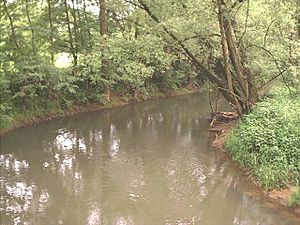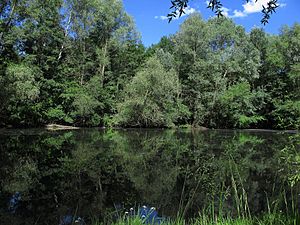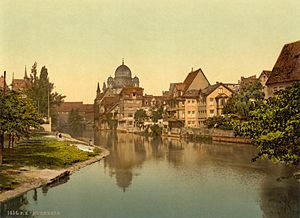Pegnitz (river) facts for kids
Quick facts for kids Pegnitz |
|
|---|---|
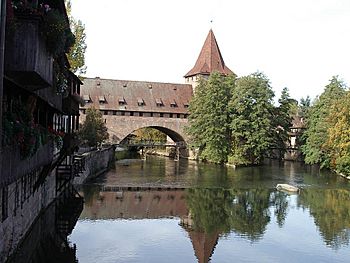
The Pegnitz in Nuremberg.
|
|
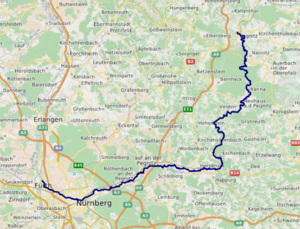 |
|
| Country | Germany |
| Physical characteristics | |
| Main source | Franconia 425 m (1,394 ft) |
| River mouth | Regnitz 49°29′11″N 10°59′12″E / 49.48639°N 10.98667°E |
| Length | 112.6 km (70.0 mi), with Fichtenohe 127.3 km (79.1 mi) |
| Basin features | |
| Progression | Regnitz→ Main→ Rhine→ North Sea |
| Basin size | 1,230 km2 (470 sq mi) |
The Pegnitz is a river in Franconia, a region in Bavaria, Germany. It's a pretty important river in this part of the country.
The Pegnitz starts in the town of Pegnitz itself. It begins at a height of about 425 meters (1,394 feet). Later, it joins another river called the Rednitz in the city of Fürth. When these two rivers meet, they form a new river called the Regnitz.
Sometimes, people think of the Fichtenohe river as the very beginning of the Pegnitz. The Fichtenohe is about 15 kilometers (9.3 miles) long. Its source is in the Lindenhardt Forest, which is north of Pegnitz town.
The Pegnitz river is about 113 kilometers (70 miles) long. If you include the Fichtenohe, it stretches to about 127 kilometers (79 miles).
Many different kinds of birds live in and around the river. You can often spot ducks, coots, swans, and gulls enjoying the water.
Rivers Joining the Pegnitz
Many smaller rivers and streams flow into the Pegnitz. These are called tributaries. They add more water to the main river as it flows along.
- Fichtenohe (joins from the left side)
- Flembach (joins from the left side)
- Hirschbach (joins from the left side)
- Högenbach (joins from the left side, from the Pommelsbrunn area)
- Happurger Bach (joins from the left side)
- Sittenbach (joins from the right side)
- Hammerbach (joins from the left side)
- Sandbach (joins from the left side)
- Schnaittach (joins from the right side)
- Röttenbach (joins from the right side)
- Bitterbach (joins from the right side)
- Röthenbach (joins from the left side)
- Langwassergraben (joins from the right side)
- Tiefgraben (joins from the right side)
- Goldbach (joins from the left side)
Cities Along the Pegnitz
The Pegnitz river flows through several important towns and cities. Here are some of them, listed from where the river starts to where it ends:
- Pegnitz: This is the town where the river gets its start.
- Neuhaus on the Pegnitz
- Hersbruck
- Lauf an der Pegnitz
- Röthenbach an der Pegnitz
- Nuremberg: The river flows for about 14 kilometers (8.7 miles) through Nuremberg. Inside the city, the river sometimes splits into smaller branches. Many bridges cross the Pegnitz here. One famous bridge is the Fleischbrücke, built in 1598, which is a Renaissance bridge that hasn't changed much. Another is the Chain Bridge (Kettensteg), an iron suspension bridge from 1824. In the western part of the city, efforts were made from 1998 to 2001 to make the river more natural again. They used the old river path as a guide.
- Fürth: Like Nuremberg, Fürth also has many bridges over the Pegnitz. As part of a project called Uferstadt (riverside city), the riverbed was made more natural in 2003. This was done where the old Grundig factory used to be. They created two new loops and made the river banks shallower over one kilometer. Some parts of the old riverbed were kept as quiet backwaters. The European Union helped pay for these changes.
History of the Pegnitz
The river is so well-known that a literary group, the Pegnesischer Blumenorden (Pegnitz Flower Society), was named after it.
In February 1909, there was a very big flood. After this flood, the river was straightened in the city of Nuremberg. This made the river four kilometers (2.5 miles) shorter within the city limits.
Since 1996, there have been plans and actions to make the river longer again between Nuremberg and Fürth. The goal is to shape it in a way that is more natural and better for the environment.
See also
- List of rivers of Bavaria
 In Spanish: Río Pegnitz para niños
In Spanish: Río Pegnitz para niños


